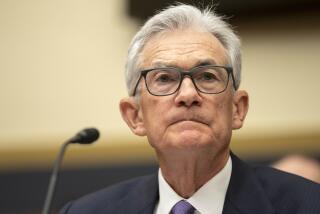Fed preparing to scale back stimulus, minutes suggest
WASHINGTON — Analysts are widely expecting the Federal Reserve to dial back its bond-buying stimulus program next month. So are bond investors and emerging markets. And it looks as if the Fed is too.
Although such action is not a sure thing, the minutes of the Fed’s July meeting suggest that policymakers are largely preparing to scale back their $85-billion monthly purchases at their next policy session in mid-September — unless the U.S. is hit with a major dose of bad economic news before then.
Fed officials didn’t reach a firm consensus at their last meeting. And they were a little more pessimistic than before about the near-term economic outlook.
Even so, the minutes, released Wednesday after the usual three-week lag, gave no indication that the Fed was pushing back against market expectations for a tapering next month.
In fact, the minutes stated that a number of Fed officials saw the market’s view of the future course of monetary policy as “well aligned with their own expectations.”
Most financial market participants view September as the likely onset of the Fed’s slowing of bond purchases, said Michael Gapen, an economist at Barclays Bank. “We see the minutes as indicating the committee is comfortable with this outlook,” he said in a research note.
Furthermore, the account of the Fed’s meeting on July 30 and 31 suggested that policymakers spent less time debating the timing of the tapering than they had in prior recent meetings.
Instead, they discussed in greater detail their communications strategy, presumably so that the Fed can effectively convey its intention and future plans so investors do not overreact to a slowing of stimulus.
“Even though they’re going to start tapering, the Fed is not rushing for the exits, which means tightening monetary policy,” said Josh Feinman, chief global economist at Deutsche Asset & Wealth Management in New York.
To make sure that’s clear to markets and to blunt a potentially bigger fallout from the Fed’s tapering, Feinman expects the Fed to emphasize with the announcement of the first cut in bond purchases that it still plans to maintain an easy-money policy for some time to come, adjusting any tapering if economic conditions worsened.
Feinman said policymakers also could indicate that they were likely to keep the Fed’s benchmark short-term interest rate at near zero for even longer than the market’s current expectations of its rising starting in 2015.
Mohamed El-Erian, chief executive of Pacific Investment Management Co., or Pimco, said much the same thing Wednesday, predicting that the Fed would not raise its so-called federal funds rate until at least 2016.
Speaking at a Washington panel on the economy, El-Erian said Fed policymakers would try to make more use of the Fed’s forward guidance to try to offset the recent jump in long-term interest rates.
Those rates have risen partly because investors have been anticipating the central bank decision to start reducing its monthly bond purchases.
“The minute that the Fed started talking about tapering … you saw interest rates taking off,” El-Erian said. “We have now priced in as a market a significant tapering starting as early as September.”
The market has sometimes behaved as if it was not distinguishing between the Fed’s bond-buying stimulus and the federal funds rate, the central bank’s conventional lever for managing the money supply and economy.
But in recent months, various Fed officials have sought to clarify that pulling back on the purchases of Treasury bonds and mortgage-backed securities doesn’t mean conditions are tightening.
Even so, it’s hard to know how bond investors will react to a tapering by the Fed. In the last three months, 10-year bond yields have risen nearly a full point to about 2.9%, and the rate inched higher after the release of the Fed’s minutes Wednesday.
The recent jump in rates also has contributed to losses in emerging markets, which are now seeing more funds returning to the U.S. to capitalize on rising rates.
Further sharp gains in long-term rates could hurt the housing market, something that Fed officials noted but were not overly worried about three weeks ago.
But the minutes did show Fed officials as generally more guarded about the economic outlook.
Fed policymakers generally expect economic growth to improve somewhat in the second half of this year, the minutes said, but they were “somewhat less confident about a near-term pickup in economic growth than they had been in June.”
The minutes cited such factors as “recent increases in mortgage rates, higher oil prices, slow growth in key U.S. export markets, and the possibility that fiscal restraint might not lessen.”
Furthermore, Fed policymakers pointed to the still-high jobless rate and other statistics, such as the large number of involuntary part-time workers and low labor participation rate, as “indicating that overall labor market conditions remained weak.”
Since the Fed’s last meeting, the government released the July jobs report, which showed slower payroll growth and a small increase in the involuntary part-time employment.
“Because there is some question still about what constitutes significant improvement in the labor market, the committee is likely to wait for the August employment report on Sept. 6 to make up its mind,” said Chris Rupkey, chief financial economist at the Bank of Tokyo-Mitsubishi.
At the end of the day, Rupkey said, the Fed is still likely to make its first bond-buying cut in September. But given the qualms still within the Fed, he said, the amount “could be quite modest.”








